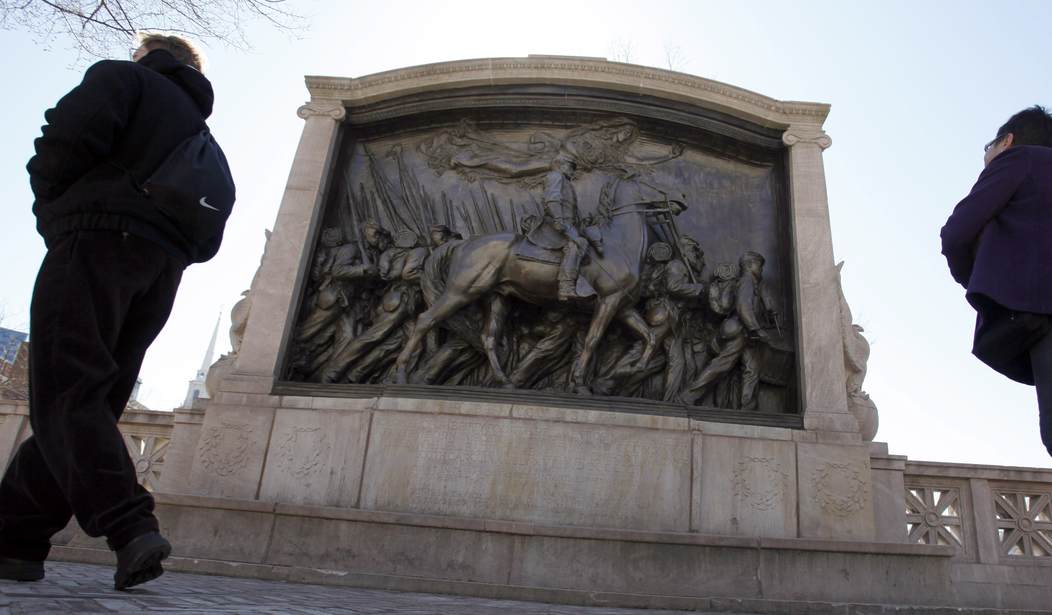Attacking, defacing and removing statues has become a growing concern over the past few years and it has accelerated over the past month. It began, purportedly, with a drive to remove the Confederate flag from some Southern states. It moved on from there to removing Confederate statues, often by mobs or by city governments with little or no public input or debate.
That discussion/vandal season moved on swiftly. Non-Confederate, non-Union, and even non-American statues have now been vandalized or even removed by mobs. These statues were typically erected on some anniversary, such as the 50th anniversary of the Civil War, and were often built to bring unity, commemorate a battle before its last surviving participants (on both sides) passed away, or for some other noble purpose understood at the time.
Others were erected for less noble reasons, such as the revival of the “Lost Cause” narrative after President Woodrow Wilson (D) re-segregated the federal bureaucracy and fostered white supremacists. Other statues were placed to help remember significant figures of the past. The statues’ message and the context in which they were placed matters. Or should.
Mobs should not be given license to deface or topple any statue, but many cities have at least tacitly approved of such destruction by keeping police from acting to stop it. Statues were placed in accordance with orderly and legal processes, and any removed should be removed through orderly and legal processes as well. Many were privately funded by groups the mobs now claim they support or even represent. New York Gov. Andrew Cuomo (D) has openly praised the vandals.
The following is a list of some of the most ridiculous statue vandalism cases of 2020. It does not include statues of explorer Christopher Columbus, without whom there would be no United States or any of the nations of the Americas, at least as we know them. It also omits most political figures, founding fathers, and Francis Scott Key, author of the national anthem, whose statue was toppled in San Francisco along with several others. It omits statues of Confederate generals or other Confederate leaders.
It also omits statues removed by orderly processes, no matter how hidden those processes were or how specious the reasons given for their removal. Some of those include the Texas Ranger statue in Dallas, the Teddy Roosevelt statue in New York, and the Abraham Lincoln emancipation statue which still stands in Washington’s Lincoln Park.
Protesters are threatening to remove that monument, and it’s under review. It is being misrepresented as Lincoln standing over a kneeling black figure, but the kneeling figure is in the process of standing up for his freedom thanks to Lincoln’s Emancipation Proclamation, which Lincoln is holding in his right hand. That statue was funded primarily by freed slaves. Frederick Douglass, the most prominent black anti-slavery leader of the 19th century, approved of the statue and delivered the keynote address at its dedication in 1876.
This list only includes statues vandalized or removed by mobs or lone actors outside legal processes in 2020 and evidently connected to the current unrest. They are in no particular order. This list is unfortunately not exhaustive.
Jose Toribio Losoya. Jose Toribio Losoya was a Tejano, born in the Alamo in San Antonio, Texas during Spanish rule. The Alamo was part fort, part neighborhood at the time. After Mexico won its independence from Spain, Losoya became a Mexican soldier. When Santa Anna became dictator of Mexico, Losoya left the Mexican army and joined the Texas cause, which was fighting for the civil and constitutional rights dictator Santa Anna had abrogated.
Losoya was not white and he never owned a slave. Losoya fought and died for freedom in the Alamo on March 6, 1836. Vandals tagged a wall next to his statue in San Antonio in late May, along with other nearby statues and monuments. Police made a swift arrest and vandalism has not continued in the city.
Miguel de Cervantes. Spanish author Miguel de Cervantes’ statue was vandalized during an orgy of statue violence in San Francisco, California on June 19, 2020. The statue attacks have supposedly been about police brutality, civil rights, slavery, or colonialism. The vandalism of Cervantes’ statue makes no sense in any of these contexts. Cervantes was a 16th and 17th century Spaniard, known mostly for his satirical novel Don Quixote, in which a goofball knight attacks defenseless windmills claiming them to be giants. Not only did Cervantes not own slaves, but he was also himself a slave — for five years.
Cervantes was not a slave on a Dixie plantation. He was a Christian, captured by the Muslim Barbary Pirates, and sold into slavery in what is now Turkey. The Barbary Pirates, who were Muslim, captured, and sold European (white) Christian slaves for centuries. Cervantes’ statue was tagged with anti-police graffiti, despite the fact that the author had no connection with any police force. Cervantes’ influence across world literature is vast and ongoing. The Expanse sci-fi TV show features a ship called the Rocinante. That was the name of Don Quixote’s horse in Cervantes’ novel. The Don Quixote tale is threaded throughout The Expanse (which is a great series, by the way).
Stevie Ray Vaughan. Stevie Ray Vaughan was not a politician at all. He had nothing to do with the Confederacy. He was not a police officer. He lived far too late to own any slaves. He was a legendary guitarist and singer responsible for helping revive and mainstream Texas blues in the 1970s and 1980s. He championed a musical style pioneered by black artists such as Lightnin’ Hopkins and Albert King, fused it with rock, and created his own amazing sound.
Vaughan was born in Dallas, Texas, took up the guitar at the age of 7. He formed his first band, Blackbird, in 1971. He was in several bands in the Austin music scene before forming Double Trouble, the band with which he would become a national name and guitar legend. His 1983 debut album, Texas Flood, was a monster hit and he followed that up with several other hits until he died in a helicopter crash on August 27, 1990. Vandals tagged his statue in Austin with “FTP” — “F*** the police” — in June 2020.
Ulysses S. Grant. During the same spate of attacks in which the Cervantes statue was vandalized in San Francisco, rioters toppled a statue of Ulysses S. Grant. Grant’s main connection to slavery was that he destroyed it. He was the Union general who defeated the Confederates’ Army of Northern Virginia and won the Civil War. Grant was born into an abolitionist family but married the daughter of a slave-holding family. Before the Civil War, his father-in-law gifted Grant a slave, but Grant chose to free the man despite the fact that Grant barely had a penny to his name at the time.
After the Civil War, President Grant, a Republican, prosecuted and nearly destroyed the Ku Klux Klan, which had been founded by Democrats who had fought on the Confederate side of the Civil War.
At the time, the Klan was “a paramilitary group devoted to the overthrow of Republican governments in the South and the reassertion of white supremacy,” according to the Miller Center at the University of Virginia. Grant protected and fought for the civil rights of the newly freed black Americans and supported and approved of the 15th Amendment, which extended the right to vote to black men. The Klan was later revived 30 years after Grant’s death when Democrat President Woodrow Wilson re-segregated the federal workforce and screened a pro-Klan movie in the White House, a film he also publicly praised.
Tadeusz Kościuszko. Tadeusz Kościuszko was a Polish nobleman who volunteered and fought in the American Revolution. An engineer, he spent the war fortifying key American positions including the home of the Continental Congress and West Point. He also blocked the roads around British forces in Saratoga, NY, leading to their surrender. He led the Battle of the 96 and the blockade of Charleston, and was such a gifted leader that the Americans granted him citizenship after the war. He left the United States to aid his native Poland, but returned after a few years. He used some of his own property to free slaves and pay for their education. The statue honoring Kościuszko stands in Washington, D.C.’s Lafayette Park, and rioters defaced it on May 31, 2020.
Hans Christian Heg. Hans Christian Heg never owned slaves at all. He was an ardent abolitionist. He was also an immigrant. Heg was born in Norway but moved to the United States in 1840. He eventually joined the Free Soil Party, which opposed the expansion of slavery into new territories and states. He was a prison reformer as well. When the Civil War broke out, Heg joined the Union cause in the Wisconsin infantry. Heg was involved in several battles in 1862 and was noted for his bravery in battle. Heg was shot during an engagement with Confederate troops on Sept. 19, 1863, and died the next day. Hans Christian Heg literally gave his life trying to end slavery.
On June 23, 2020, rioters senselessly toppled the statue of Hans Christian Heg in Madison, Wisconsin. During the same spate of violence, rioters assaulted WI state Sen. Tim Carpenter, a gay liberal Democrat from Milwaukee.
Forward. During the same spate of violence in Madison, WI, rioters toppled a statue dedicated to progress (which says a lot). That statue was originally created in 1893 to symbolize Wisconsin’s dedication to forward progress. According to the Milwaukee Journal Sentinel,
“Forward depicts a woman standing on the prow of a boat, the figure-head of which is ‘Old Abe,’ according to the Historical society. Old Abe, who was named after President Abraham Lincoln, was the mascot of the 8th Wisconsin Infantry and became an inspirational symbol of Union troops and Wisconsin’s Civil War history in the decades that followed.
“The boat is surging through the water, and the figure, poised gracefully but firmly upon the prow, stretches forth the right hand, while the left clasps the American flag to its bosom,” the Historical Society says.
The real statue was moved to preserve it in the 1990s, so what stands outside in Madison — and which rioters toppled — is a replica.
Matthias Baldwin. Matthias Baldwin was an abolitionist in Philadelphia, PA born in 1795. Baldwin was a successful jeweler and locomotive manufacturer. He hired black workers in shops he owned and supported black voting rights as early as 1837. Baldwin set up schools for black children. He even faced a boycott by southerners because of his lifelong abolitionism and activism. Rioters defaced his statue, which stands outside Philadelphia’s city hall, in early June 2020.
The 54th Massachusetts Regiment. In Boston stands a monument to a regiment that fought valiantly on the Union side in the Civil War. The 54th was most notably engaged in an assault on Fort Wagner on July 16, 1863, during which their commander was killed and the regiment suffered devastating losses. About half of its men were killed, but none wavered in the face of extremely heavy fire.
The 54th Massachusetts was the first all-black volunteer regiment in the United States military. Its valiant conduct in the battle at Fort Wagner earned the nation’s respect and changed minds. The 54th Massachusetts were brave men who proved racists wrong. The 54th Mass monument is regarded as one of the finest public art pieces in the nation. But rioters vandalized the monument honoring the 54th on May 31, 2020, which happened to be the 123d anniversary of its dedication.









